#the goodreads account was about more easily documenting my reads
Text
Year in Review - BOOKS - 2023
Audiobooks read:
Anxious People by Fredrik Backman
DisneyWar by James B. Stewart
A Caribbean Mystery by Agatha Christie
Rough Magic by Lara Prior-Palmer
Horse Crazy by Sarah Maslin Nir
Nona the Ninth by Tamsyn Muir
Eleanor Oliphant Is Completely Fine by Gail Honeyman
A Man Called Ove by Fredrik Backman
The Alchemist by Paulo Coelho
The Player of Games by Iain M. Banks
The Midnight Library by Matt Haig
A Murder is Announced by Agatha Christie
Remarkably Bright Creatures by Shelby Van Pelt
The Metamorphosis by Franz Kafka
As Long as the Lemon Trees Grow by Zoulfa Katouh
Legends and Lattes by Travis Baldree
Into Thin Air by Jon Krakauer
Born to Run by Christopher McDougall
The Gentle Art of Swedish Death Cleaning by Margareta Magnusson
I Kissed Shara Wheeler by Casey McQuiston
A Court of Thorns and Roses by Sarah J Maas
As You Wish by Cary Elwes, Joe Layden
Ninth House by Leigh Bardugo
The Measure by Nikki Erlick
Ready Player One by Ernest Cline
The Silent Patient by Alex Michaelides
eBooks read:
A Court of Mist and Fury by Sarah J Maas
A Court of Wings and Ruin by Sarah J Maas
A Court of Frost and Starlight by Sarah J Maas
A Court of Silver Flames by Sarah J Maas
Project Hail Mary by Andy Weir (In Progress)
Regular books read:
Wet Moon Volume 4: Drowned in Evil by Sophie Campbell
Princess Jellyfish Volume 3 by Akiko Higashimura
Color and Light: A Guide for the Realist Painter by James Gurney (In Progress)
It felt like I read a lot more this year, but looking back at previous years, not by much! What really happened is I joined not one, but TWO book clubs - one with work and one with friends. It's definitely helping me explore outside of my normal tastes, and I've found some great stuff.
In 2023, I branched away from audiobooks and into ebooks in the interest of not listening to fairy smut on my speaker, and instead reading it on my phone as god intended.
I finally started a GoodReads account, but I'll probably still do these yearly round-ups here on tumblr. But now I can more easily endorse (or roast the fairy smut) items on my my reading list.
#book year in review#books#life interruption#year in review#about me#the goodreads account was about more easily documenting my reads#and ALSO so i could leave an angry review b/c christ
3 notes
·
View notes
Text
2020 Life Olympics
The real Olympics may have been canceled in 2020 but the Life Olympics persevered like the postal service of Olympics.
First, I’d like to apologize for my role in the chaos of 2020 because I think I had a slight miscommunication with the powers that be and I feel partly responsible. Here was my plan for 2020:
My theme for 2020 is Intention because I want to take the energy I feel right now and deploy it with more intentionality next year - bringing increased mindfulness to how I spend my time, money, physical and mental energy. And because I love wordplay, I also literally want to spend more time camping “in-tent” to enjoy more peace and quiet and beauty in nature.
The universe was like, “Oh, she wants to spend less money and more time outside? Well, shut it down. Shut the whole planet down.”
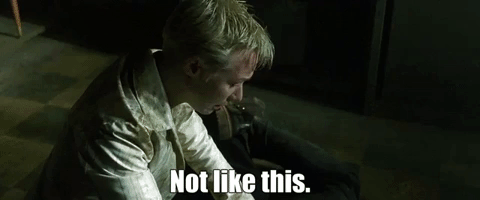
I mean, mission accomplished, I guess? I did spend less money and more time outside and had to be VERY intentional with my mental energy to survive the day-to-day morass of 2020. Next time, I will be more specific with my annual manifestations. Sorry to all.
2020 was brutal for pretty much everything and everyone. I don’t know anyone who isn’t in some state of grief right now, including myself. I debated doing a Life Olympics at all this year, feeling like-- what is the point? Hundreds of thousands of people died, our democracy is hanging on by a thread, and millions of people lost jobs, businesses, and homes.
Like many people, I’ve been struggling with anxiety and depression this year which intensified as it got darker and colder outside. At a low point, I talked with my therapist about the struggle of just not wanting to do any of the things that usually bring me joy-- and how periods of relief were so fleeting. “But you have to keep doing those things,” she said, “even if they’re not working right now, you have to keep doing those things and trust the process; the joy will return.”
So even though I don’t really feel like it and kind of feel like it’s dumb, I’m writing the 2020 Life Olympics. I’m trusting the process.
2020 Life Olympics Recap
Work - Participation Trophy
Starting a company is hard, operating a company is harder, but running a company during a global pandemic and economic crisis is something I wouldn’t wish on my worst enemy. 2020 was not a fun year to lead a business; it was hell. On March 15, the plan for the year pretty much went out the window and everything went into survival mode. I never take the company or my team for granted, but I’m particularly grateful to be able to usher this work into 2021.
Despite the craziness, we still had some big wins this year. We launched new product partnerships with PowerSchool and Amazon Business. We rebuilt our tool for equitably calculating district funding formulas. And I got to flex my creative muscles with EdFinToks! Throughout it all, I was lucky enough to be surrounded by a team of people who are as compassionate as they are talented.
I’m worried about public education more than ever after this year, but I’m going to keep fighting every day to make it work better for kids.
This is Work-Lite but I also spent a good chunk of time this year leading the modernization workgroup for Bill Henry’s transition committee after his spring primary election to become the new Baltimore City Comptroller, ousting a 25-year incumbent, Joan Pratt. This was an enlightening (and infuriating) experience for me that gave me a glimpse into the operations of a segment of the City government. This process also really helped crystallize how much I enjoy making public agencies function more efficiently; I’m excited to see what Bill does with the recommendations (some are already being put in action!)
Health - Gold
This is the second year in a row (and ever) that I’m giving myself a Gold medal for Health. This was easily a year that I could have regressed on all of my healthy habits and no one would have blamed me. Instead, I leaned into protecting and improving my physical and mental health in 2020. It’s not an exaggeration to say that walking probably saved my life this year. I spent a lot of time walking around my neighborhood and various state and city parks-- walking is maybe not the best word; I stomp and charge around like I have a score to settle with the ground beneath me. My walking increased 370% in 2020. This is a habit of 2020 that I’d like to keep. My brain and body are happier if I can spend a little time walking-- stomping-- around outside each day.

I also did a lot of biking this summer. My cycling increased 200% this year-- with much more time spent cycling outdoors. My crowning achievement this year was biking to and from Annapolis:
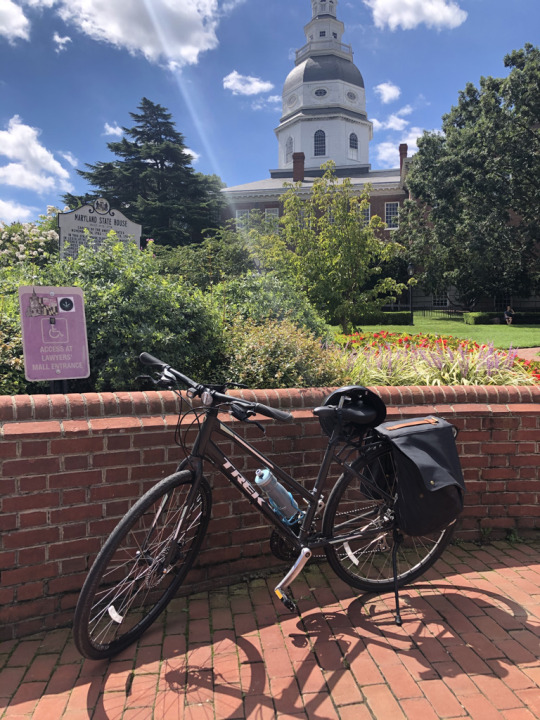
I spent a LOT more time outside this year which was critical for my mental health. On the downside, I only did 90% as much yoga and 60% as much strength training, so I want to try to be a little more balanced next year.
I also invested a lot in my mental health this year. I kept up with therapy every 2-4 weeks and in October I decided to pursue a formal diagnosis for ADHD which I definitely have! Needless to say, staying in one place this year has been a special kind of hell for me.
Home - Silver
Well, I definitely spent less money this year. And the way I did spend money made me (mostly) sad:
Travel down 70%
Auto & Transportation up 200% (boo cars)
Shopping down 60%
Personal Care down 35%
Gifts and donations up 200%
Food and Dining down 40%
Entertainment down 35% (I kept up my singing lessons virtually which accounts for a lot of this category)
2020 was quite the palate cleanser from my 2019 year of hedonism but maybe we can go for a happy medium in 2021? Just kidding-- I will resume my hedonist ways the minute the world opens.
I also redid my home office like every other work-from-homer on the planet and replaced my crumbling kitchen floor so the house got some TLC.
But nobody enjoyed having me home all year as much as Darwin:

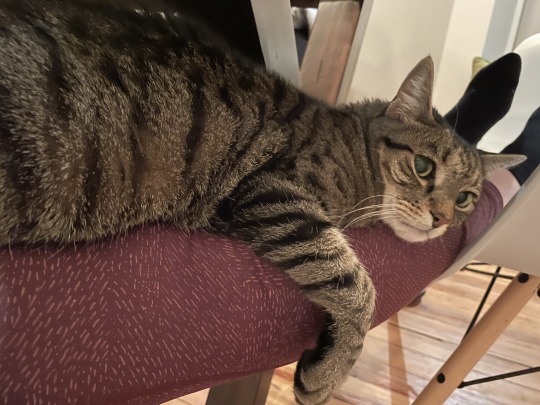

Relationships - Bronze
What a weird year for relationships of all kinds. I’m giving this a Bronze because while I invested a lot into a few relationships this year, there are also a lot of people in my life to whom I haven’t been able to give my time and love.
One of the most important relationships in my life this year was with one of my former students. After bouncing around in the foster system for many years, we reconnected around the holidays in 2019 and he started crashing with me while we tried to figure out stable housing and employment. He was arrested in January and was incarcerated for the next several months awaiting trial. Finally, we were able to negotiate a plea agreement with the State’s Attorney and he came home around Independence Day. We spent the next several months getting him set up with a phone and various identification documents-- a nightmare in normal times and a total abyss during the pandemic. I got him registered to vote when we got his ID card and I took him to vote for the first time (a supreme treat for this former social studies teacher):

He’s now got a full-time job and stable living situation. Calling this THE success of 2020. Thank you to everyone who helped me with resources all year for housing, legal processes, and documents. It takes a village.
It was a bizarre year for family. We lost my grandmother in September, so not being able to spend the holidays together felt like an especially cruel loss. Other big losses this year include a trip to France to celebrate a milestone birthday for my mother and my brother and sister-in-law’s wedding (Mosby seemed pretty ok with the alternative plan, though):


But in many ways, my family has been more together than ever this year thanks to prolific group chats and photo-sharing. Mostly, I’m just glad everyone else is safe and healthy. As my father often reminds me, “Our problems are small.”
And dating? What to do with this weird Jane-Austen-esque dating scene-- as if modern dating weren’t fraught enough. Is this the universe punishing me for ending my 2019 dating hiatus early? I, for one, have given up. You win this one, pandemic. I’m just going to have my little Twitter crush and call it a year. Next year, though...

Horizons - Silver Gold
You know what? It’s hard to expand your horizons without people or places.

I did the best I could. I finally got back on track with my Goodreads challenge and actually had a really good year of reading, including finally embracing audiobooks through my Libro.fm subscriptions. I especially enjoyed Michelle Obama’s book Becoming and Mike Birbiglia’s The New One on audio-- both narrated by their authors.
I camped in Pocomoke (MD), Western MD, Lake Michigan, and Ohiopyle (PA):




I explored over 30 new hiking/biking trails-- some favorites including the Youghiegheny River trail in PA, the NCR trail, Catoctin Mountain, the C&O Canal Towpath, Annapolis Rock, and of course, Stoney Run in my backyard.
I left Facebook and started the Life Olympics newsletter. I’ll be honest, I don’t miss Facebook but I also don’t understand where that energy, time, and brain space went. I was spending cumulatively hours a day mindlessly scrolling Facebook and I quit cold turkey and barely noticed-- what black hole of our brains does social media occupy? I kind of thought that with all that extra time I would write the next great American novel or something. I’m probably spending a little more time on Twitter, which I could stand to cut back on. Other than that, I think I was just trying to process the shitstorm of this year. Maybe I’ll write the next great American novel post-pandemic.
For the first time in my life, I feel somewhat ‘caught up’ on pop-culture. I finally watched Parks and Recreation (twice); I watched The Mandalorian and finally actually watched Star Wars (episodes IV-IX); I watched the final seasons of The Good Place and Schitt’s Creek; I’m caught up on Insecure; I watched The Prom and Ma Rainey’s Black Bottom and Jingle Jangle; I even started Bridgerton. I know what everyone is talking about and I’m catching so many more pop-culture references these days. (I guess instead of writing the next great American novel I watched Netflix?)
2020 Lessons
I’ve spent plenty of time mourning the missed opportunities of 2020 and will probably always wonder what this year could have been in an alternate universe with a functioning government. But we only have this reality for now, and we made the best of it.
I wanted to slow down in 2020, try to be more intentional, more mindful, and...
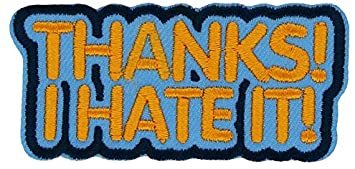
No thank you! I liked the pace of my life; it makes my brain and heart happy. I’m happiest when I wake up in a different city three days in a row. I like darting around every borough of Manhattan for nine meetings and three cocktails and then taking a red-eye to Europe. I want to run around to eight conferences for 18-hours a day for three weeks and then sleep for 22 hours. I miss overloading my brain so much that I need a deprivation chamber to sleep. This is who I am. This is how I like to live. And when I was locked down alone in the house for a year, slowing down, being mindful, I never once thought, “I should have... when I had the chance.” Because I always did. And I always will.
2021
We shake with joy, we shake with grief.
What a time they have, these two
housed as they are in the same body.
Mary Oliver
We’ve had enough grief. 2021 is going to be all about joy.
Universe, let me be clear: this is not a euphemism or code or secret signal.
I want pure, unadulterated, abundant, joy. I want multi-course dinners in restaurants with lots of close friends and good wine. I want the virus so far gone that I can make-out with handsome strangers. I want a rollicking good time in France and/or Brazil and/or Prague and/or New Zealand and/or Bali. I want to spend the day after Christmas in NYC with my father. I want to be a glutton for theatre and art and music. I want celebrations and parties and sequins.
I want to shake with joy.

If you’d like to receive the (shorter) monthly Life Olympics, subscribe here.
2 notes
·
View notes
Text
Inside the deceitful mind of a fake book review fraudster
“Chaos and Grime” author accused of making dozens of sockpuppet accounts on Amazon and Goodreads to write glowing reviews of his own book.
On January 1, 2020, a foreign exchange student based in Xiaogan, a suburb of Wuhan China, using the alias Jacob Acerbi published a new book on Amazon titled Chaos and Grime: A Year in the Life of a Chinese City.
It claims to be a memoir about his year in China, but the synopsis paints it more as a fictionalized romance/thriller:
“Jim and a local peasant girl meet and fall in love. Yet their relationship must remain secret, for reasons that put both of their lives in jeopardy. Their story leads to devastating revelations about what really happens to China’s “leftover women” and how the authorities stop at nothing to try to prevent such knowledge from getting out.”
The synopsis is also laced with every cliched China-book buzzword lifted right out of a Peter Hessler press release:
“a window into the lives of Chinese peasants...takes you where no memoir has dared to go...a complex portrait of contemporary China....in the midst of this rapid and chaotic transformation...a society in flux...”
Most audaciously, the book claims to be “OFFICIALLY BANNED IN CHINA BY THE COMMUNIST PARTY'S MINISTRY OF FOREIGN AFFAIRS (on March 9, 2020)”:
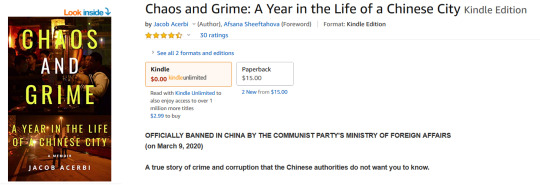
However, since there was no statement made by the General Administration of Press and Publication (新闻出版总署) about this book, and since publishing and censorship do not fall under the purview of the Ministry of Foreign Affairs of the People's Republic of China (中华人民共和国外交部), we can reasonably deduce that this claim is exaggerated if not outright fabricated.
The Amazon reviews are (so far) all positive, albeit SO glowing that one can’t help but wonder if they were purchased on one of those Buy Amazon Review sites based out of Bangladesh or Russia (you write the review yourself and pay them a fee to post it).
This 5-star review by Warrior Lodge (who also reviews office chairs and windshield wipers) seems particularly suspect:
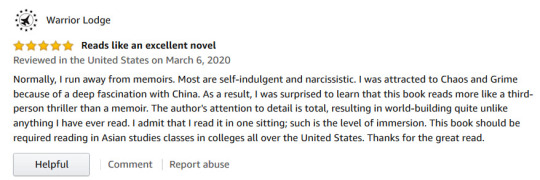
“The author's attention to detail is total, resulting in world-building quite unlike anything I have ever read. I admit that I read it in one sitting; such is the level of immersion. This book should be required reading in Asian studies classes in colleges all over the United States.”
###
SO…let’s hop on over to GoodReads, where users are more discerning and critical, but where fraud and manipulation by self-published authors desperate for attention are also rampant.
Uh oh! Several 1-star reviews, from real, regular GoodReads users who recently participated in the author’s free giveaway:

“This author is vindictive. Like his reviews, and you're all good! Dislike them, and he's rude!” and “The subtitle should have been: A Bunch of College Kids Get Drunk A Lot and Have Indiscriminate Sex. It just happens to take place in Wuhan.”
Along with more exalting reviews:
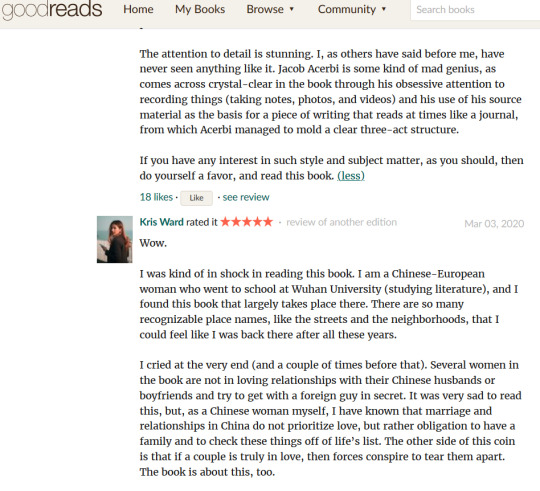
“I cried at the very end (and a couple of times before that).” and “The attention to detail is stunning. I, as others have said before me, have never seen anything like it. Jacob Acerbi is some kind of mad genius.”
Some GoodReads users also participated in a discussion on the book’s page about if Chaos and Grime would be a good choice for a woman’s book club.
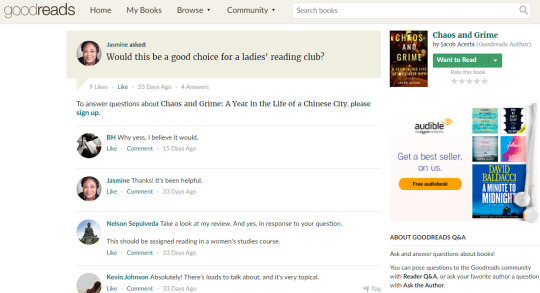
The asking user, named Jasmine, a black women in Missouri, has only reviewed 1 other book. The rest of her GoodReads profile is activity exclusively about Chaos and Grime.
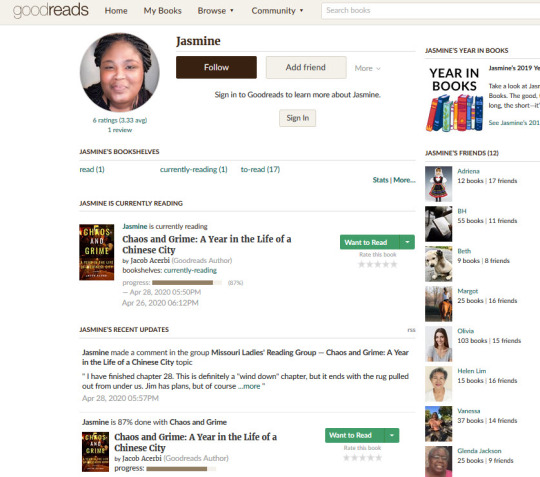
A quick reverse-image search on TinEye reveals that “Jasmine” is actually the photo of the late Jazmond Dixon of St. Louis, who died on March 24, 2020, from Coronavirus. But perhaps Jasmine is Jazmond’s twin sister who really, really loves obscure China expat memoirs, so we will give her the benefit of the doubt for now.

Jasmine is new to GoodReads, but just three days after opening her account she started a group called Missouri Ladies' Reading Group which instantaneously attracted 4 other women (all also brand-new GoodReads members; only one of them, an elderly woman named Helen Lim, has her account set to public, so we can view her activity. Just like Jasmine, her activity is also exclusively dedicated to Chaos and Grime. According to TinEye, her avatar is a stock photo.

Reading “their” discussion about Chaos and Grime is a thing of cringey beauty. Presuming that these are all sockpuppet accounts, the conversation that ensues on the Missouri Ladies' Reading Group is essentially Jacob Acerbi talking to himself over the course of 114 (and counting) posts! I’m talking VERY in-depth and lengthy analysis. That’s an autistic-level of focus and obsession (unmatched only by my own autistic-ish determination to document all this):
Glenda (also an elderly black woman): “I was talking to my pastor about this book today. He's gonna read it.”
Vanessa: “The underlying point that he was attempting to illustrate through these evasions and equivocations was the significance of the common law precept of...”
Jasmine: “With the amount of content condensed in this book it could easily be 1000 pages long if each item was expanded into a more thorough discussion like the beginning of the chapter and the other romances. It is very unusual. I like this book a lot!”
Helen: “Jacob Acerbi has a story to tell and important related cultural phenomena to communicate, and so I think that the narrative voice is there to convey things as objectively as possible. Having this story coming from the voice of "Jim" would make it too subjective. Having it the way it is means that the author is making authoritative statements as a historian, which I believe he is.”
I’ve archived “their” entire discussion here:
1) https://archive.is/H8jhN
2) https://archive.vn/LxfU8
3) https://archive.vn/ADFs7
I encourage you to read it for an embarrassed, sad-cringe laugh, but also for a chilling glimpse into the mind of someone who might be suffering from Multiple Personality Disorder or Narcissistic Personality Disorder - or both. It’s as if Kevin Crumb (played by James McAvoy in the horror movies Split and Glass) had access to Chaos and Grime and GoodReads while locked up in his mental asylum):
But let’s go back to all those glowing reviewers (including Jasmine and Vanessa and Helen) on Chaos and Grime’s main GoodReads page. Click on any two reviewers’ accounts concurrently (for example Nelson and Olivia); provided they are set to public, what do you notice? Yes – THEY ARE ALL FRIENDS WITH EACH OTHER! They each have the exact same 10 or 11 friends (no other real GoodReads users), all whom are rabid fans exclusively of Chaos and Grime – no other books!
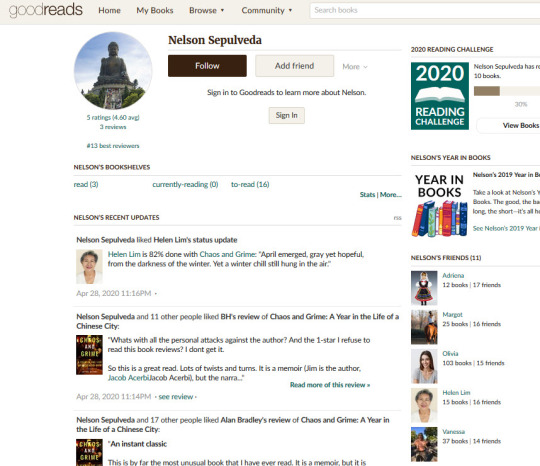
Someone also went through the trouble of creating dozens of new GoodReads Listopia reading lists with bombastic titles like “Most Anticipated Releases of 2020” and then voting up Chaos and Grime to the very top of each. And who were those 10 voters? You guessed it! Jasmine, Olivia, Helen, BH and the rest of the Chaos and Grime sockpuppet gang.
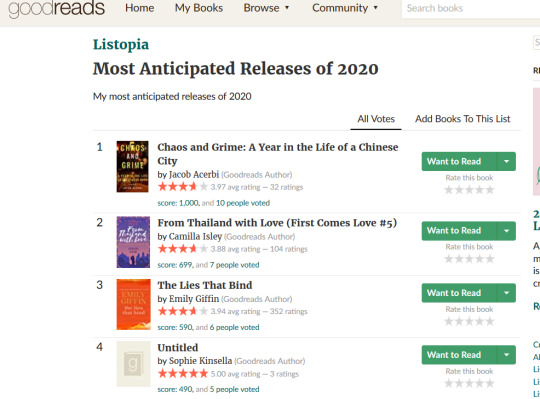
###
We’ve established that Jacob Acerbi is obviously very desperate for reviews of his new book, but can we really fault him? I mean, there was absolutely nothing in the newspapers about Chaos and Grime (very unusual for a book “officially banned by China”; the Global Times and the South China Morning Post definitely should have covered the big news), which leads us to believe that his publisher doesn’t have a very effective marketing department. So who is this publisher?
According to Amazon, Chaos and Grime was published by LSI Holdings. Strange name for a publishing house. Let’s have a look at their website.
According to ICANN the site was created on 12/28/19 – just three days before Chaos and Grime was published.

And yet, in their About Us section, they claim to “publish a large number of books each year.”
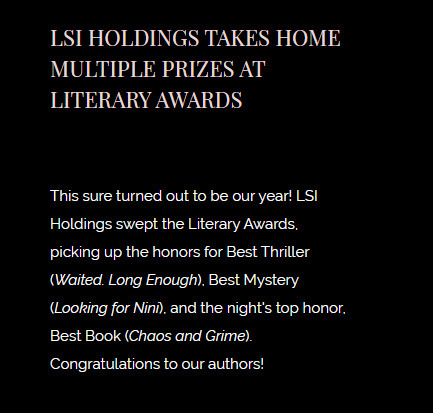
Okay, but in their Books section, they only show 4 titles : Waited. Long Enough, Looking for Nini, You’re Not A Hoarder, and Chaos and Grime. And among those titles, ONLY Chaos and Grime is listed on Amazon/GoodReads. None of the other books are found anywhere.
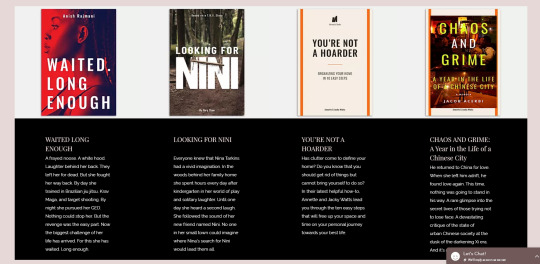
But that’s forgivable, because Wow! Check this out! All 4 books won multiple “literary awards”. No need to even name the awards, they were that good! And you wouldn’t believe which title won “Best Book”. Wait for it...Chaos and Grime!

LSI Holdings LLC must be some kind of indie publishing powerhouse! Who is this amazing team? Taylor Quill!!! And, oh cool, Melanie Boykins! And, yes!!!, the lovely Margaret Jiang in HR! She’s really great. In fact, they are all so legendary that none of them have need for LinkedIn or social media. Their sole online presence is on LSI Holdings:

###
But now I’m really inspired to read LSI Holdings’ award-winning literature, so I google Anish Rajmani, author of Waited Long Enough, which sounds like an epic read. Hmmm, seems she has TWO publishers – the other named Beadle Books.
What the…??? The EXACT same books as LSI Holdings (except for Chaos and Grime) and the exact same authors (minus Jacob Acerbi). And now I’m even more confused, because author Ash Marcus is suddenly black, and Charlie McMann is white...and a w-w-woman!

Something funny is going on around here.
Could it be that, on top of making fake Amazon and GoodReads shill accounts, Jacob Acerbi also set up a website for a fake publisher, to hide the humiliating fact that he’s, GASP!, a self-published author? After all, Amazon’s Kindle Direct Publishing (formerly CreateSpace) allows paying authors the option to mask that they published via KDP simply by providing a “publisher” website.
Rounding out the elaborate ruse are:
1) Jacob Acerbi’s (very crappy) Twitter feed (with just 16 followers at present, though he is adding dozens of bot-followers by the day) with spammy posts composed only of hashtags:
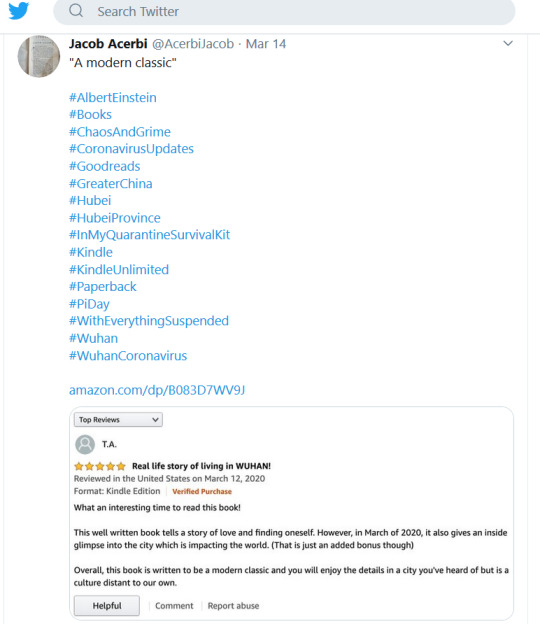
2) Inserting Chaos and Grime on the Wikipedia page for Xiaogan:

3) A faux-foreword in his book written by one Afsana Sheeftahova, a “distinguished professor of humanities at the Tajik University of Geosciences” who is also an online ghost that doesn’t exist in this world:
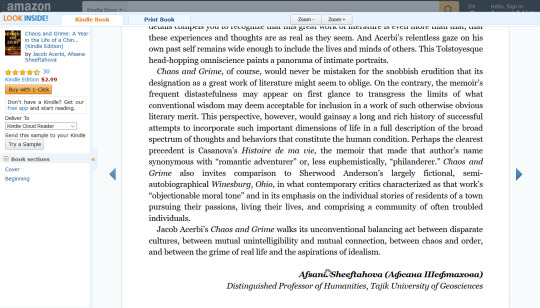
###
So what’s Jacob Acerbi’s endgame? If it’s to make money selling his book, his long-con tactics are deceitful if not downright dishonest. Fake reviews and claiming fake literary awards are the equivalent of putting misleading labels on food; some suckers are going to pay their hard-earned money on something that’s just not as tasty as the slippery salesman said it was. That’s kinda lame, bro.
On the other hand, what if Jacob Acerbi is just trolling us? Having a good laugh while taking notes on how gullible the sheeple on GoodReads (which is largely a popularity contest) are, and how easily he can manipulate the site (which is owned by Amazon) before admin get wise and shut down his account.
He also seems to be purposely making a mockery of the tired and passe China expat memoir genre (Peter Hessler, Michael Meyer, etc.). Perhaps once upon a time Acerbi did really want to write a legitimate book about his experiences in China, failed to find an agent or publisher, then said ‘f*ck this and f*ck you’ and turned it all into a satirical social experiment. After all, the author’s bio is clearly taking the piss on all those self-important China Watchers and self-proclaimed Sino Specialists with their self-aggrandizing bios:
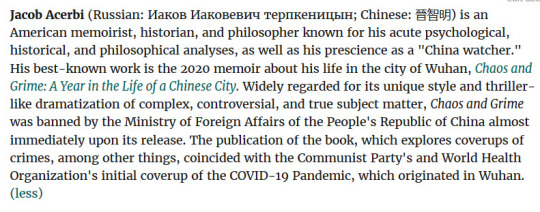
“Jacob Acerbi (Russian: Иаков Иаковевич терпкеницын; Chinese: 晉智明) is an American memoirist, historian, and philosopher known for his acute psychological, historical, and philosophical analyses, as well as his prescience as a "China watcher." His best-known work is the 2020 memoir about his life in the city of Wuhan, Chaos and Grime: A Year in the Life of a Chinese City. Widely regarded for its unique style and thriller-like dramatization of complex, controversial, and true subject matter, Chaos and Grime was banned by the Ministry of Foreign Affairs of the People's Republic of China almost immediately upon its release.”
And how can anyone take this slightly racist, slightly homophobic announcement on his publisher’s website seriously?
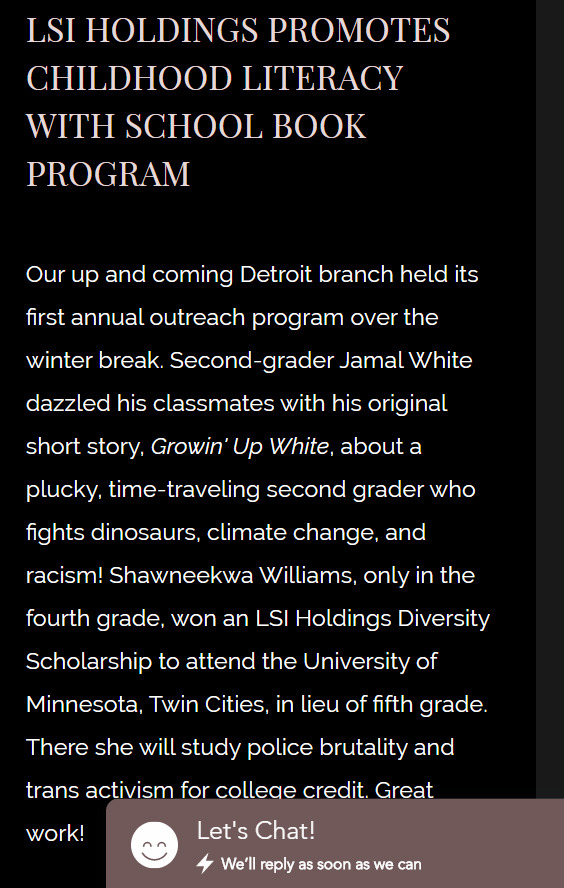
“LSI HOLDINGS PROMOTES CHILDHOOD LITERACY WITH SCHOOL BOOK PROGRAM - Shawneekwa Williams, only in the fourth grade, won an LSI Holdings Diversity Scholarship to attend the University of Minnesota, Twin Cities, in lieu of fifth grade. There she will study police brutality and trans activism for college credit. Great work!”
In conclusion, I admittedly have not read Chaos and Grime and don’t have any desire to (at this point I have read enough China expat memoirs to last me a lifetime). But I was very interested in uncovering just how low Jacob Acerbi is willing to go to promote his book (or troll us).
Now that I have tracked down his sloppy digital footprints and connected all the dots, I am left wondering: if he had put this much effort into his storytelling and writing craft, he might have actually found a real publisher, in which case, Jacob Acerbi would not have had to stoop to such shameless depths. It’s a little slimy, a little pathetic; but also a little funny.
#Jacob Acerbi#Chaos and Grime#Books#Authors#Self-publishing#Fake Book Reviews#GoodReads#Fake Amazon Reviews#Fake GoodReads Reviews#Scams#Fraudsters#Shills#Trolls#Publishing#Marketing Strategies#Self-promotion Strategies#Literary#Amazon#China#Chinese#Wuhan
3 notes
·
View notes
Link
This is a list of creative writing and self-publishing tools, apps and websites + a few extra that I thought would help!
ONLINE WRITING ENVIRONMENTS
750WORDS – a simple site to keep up a private diary or daily writing practice. You can earn badges and get some neat metrics after you complete your writing.
GOOGLE DOCS – I wrote a whole post about HOW WRITERS CAN USE GOOGLE DOCS!
NOISLI – noise generator and distraction-free writing (with Markdown preview).
WRITE OR DIE – no other app can make you write faster! A NaNoWriMo staple.
WORKFLOWY – a beautifully simple web/mobile app for outlining and list-making.
TWINE – a visual interface for creating “choose your own adventure”-style stories. WATCH THIS VIDEO for a great introduction.
NOTION.SO* – a beautiful web (+Mac & iOS) app for writing and/or creating worldbuilding wikis. CLICK HERE TO SIGN UP and earn 150 extra content blocks.
STATIONERY
GALEN LEATHER – beautiful leather traveler’s notebooks, pen cases, notebook covers and more.
CULTPENS – I order most of my fountain pens from CultPens in the UK. My go-to pens are the Kaweco Sport, Conklin Duragraph and Pilot Penmanship.
PAPERCHASE – I love Paperchase padfolios!
ONLINE DICTIONARIES
BEHIND THE NAME – my favourite resource to research name meanings, and find character names.
WEBSTER’S 1913 – a lovely nice vintage alternative to modern dictionaries, especially useful for historical fiction.
WORDNIK – one of my favourite tools for discovering and collecting words!
MAC APPS FOR WRITERS
SCRIVENER – excellent for organising (and reorganising) longer projects. If you use Scrivener for novel writing, you might like to download my ONE PAGE NOVEL TEMPLATE.
NOTATIONAL VELOCITY – I use this for all odd notes. It’s quick, simple, beautiful, and saves all files as .txt.
FLUX – Flux automatically adjusts the colour temperature of your screen according to the time of day. I find it really helps me with eye strain!
SOCIAL MEDIA & EMAIL MARKETING
BUFFER – I love Buffer not just for their amazing app, but also because they write the best blog on social media.
ACTIVECAMPAIGN* – I have yet to find a more elegant solution for automated email campaigns.
CONVERTKIT* – another fantastic email marketing solution, especially for email courses.
MAILERLITE – a great free solution for drip-style email automation.
BOARDBOOSTER* – allows you to automate posting to your Pinterest boards. Free for the first 100 pins.
CHROME EXTENSIONS FOR WRITERS
NOISLI – simple and beautiful noise generator which allows you to create and save sound combinations.
LANES – if you’re a fan of the Pomodoro Method, this is a lovely extension that turns your new tab page into a pomodoro timer and todo checklist.
MOMENTUM – similar to Lanes, this extension turns your new tab into a beautiful dashboard.
DRAFTBACK – an amazing extension that helps you visualise the writing and editing of Google documents. READ MORE HERE.
STAYFOCUSED – block yourself from time-wasting sites. I use this to combat my Youtube addiction.
ONLINE WRITING COURSES
THE WRITEMBER WORKSHOP – my friend, Faye Kirwin’s beautiful course on making writing an easy, joyful, daily habit.
THE ONE PAGE NOVEL – my course on how to plot your novel on one A4 page.
HOW TO BE THE HEROINE OF YOUR OWN STORY – my course on how to develop your character (and yourself) on one page.
MASTERCLASS WITH JAMES PATTERSON* – bestselling author, James Patterson’s tips for writing a novel.
LEARN SCRIVENER FAST* – Scrivener is an incredibly powerful piece of software, but if you’re having trouble getting started with it, this course can help!
ONLINE WRITING COMMUNITIES
MYWRITECLUB – a site for communal writing sprints and word tracking. You can follow me HERE.
4THEWORDS – a fun, gamified writing community where you battle monsters as you write, complete quests and earn crystals.
WORDWAR.IO – word war chatrooms from the creator of Write or Die.
IOS APPS FOR WRITERS
SCRIVENER FOR IOS – this is hands-down the best and most beautiful iOS word processor.
HANX WRITER – I’ve written about how much I LOVE HANX WRITER before.
NOTABILITY – this is a great app for importing PDFs (such as WRITING WORKSHEETS) and handwriting over them.
AMBIENT NOISE
I find ambient noise to be extremely helpful when I’m trying to focus on writing. In addition to the previously-mentioned NOISLI, here are a few sites/apps you might like to try…
AMBIENT-MIXER – Ambient-Mixer allows you to create your own custom soundscapes, or to use ones created by other users. My favourite is THIS HOGWARTS LIBRARY MIX.
BRAIN.FM – in all honesty, I didn’t think this worked for me, but I’ve seen many people swear by it, so it’s worth a try.
COFFITIVITY – if you’d like to create a café atmosphere in your home, this is the web/mobile app you want.
ONLINE PUBLISHING COMMUNITIES
Wattpad – Wattpad’s strength lies in its mobile app which is very convenient for reading. It also provides great opportunities to connect with your readers and some basic metrics on how they are engaging with your stories. – Since my account was deleted without reason or warning, I can sadly no longer recommend Wattpad as a safe platform to share stories.
GOODREADS – you might not be aware that you can actually publish your own stories on Goodreads. You’ll need to login, GO TO THIS PAGE, then find the small link that says, “my writing”. I admit I haven’t tried it yet, but I love Goodreads as a book community, so I have high hopes. :)
PRODUCTIVITY TOOLS
THE PRODUCTIVITY PAGES – my paper-based goal and task-tracking solution for writers.
TODOIST – a beautifully minimal to-do list app.
RESCUETIME – automatically tracks how much time you use in each app, and gives you a productivity score based on which apps or websites you designate, “productive” and which “distracting”.
TRELLO* – a task-management app that uses boards, lists and cards. A very nice solution if you like a more visual approach. I also recommend adding the SLIM LISTS CHROME EXTENSIONto fit more on your screen.
PDF TOOLS
DOCHUB – PDF editor that you can add to your Google Drive contextual menu, or as a Chrome app.
SMALLPDF – some fantastic PDF conversion and compression tools!
PDFESCAPE – this tool makes me SO HAPPY! You can upload your PDFs and quickly and easily turn them into forms. Love it.
IMAGES
FIRMBEE – a collection of public domain mockups to use for marketing your books.
UNSPLASH – gorgeous public domain photos to use in your blog posts, book covers, or social media graphics.
GRAPHICBURGER – mockups and graphics to use in your ebooks or emails.
CREATIVEMARKET* – a great resource for images, fonts, templates and themes. Don’t miss their weekly free goods!
CANVA – an online image editor that has pre-made templates for Kindle ebook covers.
WEB SITES
WORDPRESS – my site runs on WordPress. I love it, although it can be a bit intimidating if you aren’t very tech-savvy.
ANGIEMAKES* – my WordPress theme is by AngieMakes. It has a ton of options and I really love it!
SITEGROUND* – my web host of choice. Their premium support is top notch!
MISCELLANEOUS
HOTJAR* – create heatmaps of your blog to see where viewers are looking and clicking.
WAVE – As far as I know, this is the only free accounting solution for freelancers and small businesses, and it works a treat!
Links with * are affiliate or referral links. But I promise I never recommend products unless I absolutely love them!
7 notes
·
View notes
Text
App To Multiple Cloud Services Accounts Mac Os
In order to make multiple accounts safe and secure, macOS compartmentalizes your data and settings, linking them to your user ID. That way, you can keep a shared Mac in the living room or somewhere else accessible to the whole family. Everyone can use it, but each person's data is siloed from other members of the family.
Best Mac Os Apps
App To Multiple Cloud Services Accounts Mac Os Download
App To Multiple Cloud Services Accounts Mac Os X
App To Multiple Cloud Services Accounts Mac Os Free
Mac Os App Store
Best Mac Os Apps
Setting up multiple users on a Mac is just as applicable to work situations where more than one employee has to use the same Mac. Individual user accounts provide the best protection for everyone: They ensure that no one accidentally deletes your data or sees information they're not supposed to see.
App To Multiple Cloud Services Accounts Mac Os Download
Note: The Managed with Parental Controls account option is the best for kids, giving parents a lot of control over how their children can access the Internet and use their Mac. To understand more how parental controls work on the Mac, read the link below!
Jan 13, 2020 iCloud Photos automatically keeps all your photos in iCloud, so you can access them on your iPhone, iPad, iPod touch, Apple TV, Mac, iCloud.com, or on a PC. When you edit and organize images in the Photos app, your changes are kept up to date and visible everywhere. Easily mount Google Drive on Mac as a local disk, using this ultimate cloud manager utility - CloudMounter for Mac OS X. Use this Google Drive client for macOS to manage your online files from Mac Finder. Protect your Google Drive documents with this Google Drive app for Mac computer.
How to set up multiple users on your Mac
App To Multiple Cloud Services Accounts Mac Os X
Select System Preferences in your dock.
Click on Users & Groups.
Source: iMore
Click on the lock icon in the lower left-hand corner of the Users & Groups window.
Enter your administrative password, and click the Unlock button.
Why are apps taking up so much space on my mac. Feb 03, 2020 So, your Mac is running out of storage. You try to figure out what’s taking up your disk space by clicking the Apple logo on the top-left of the screen, selecting About This Mac, and hitting the Storage tab. To your surprise, you see a yellow bar representing “System” that seems to occupy way more space than you think it should. Aug 31, 2016 Do the same in other applications, such as Aperture, that have an internal Trash feature. Then restart the computer. That will temporarily free up some space. According to Apple documentation, you need at least 9 GB of available space on the startup volume (as shown in the Finder Info window) for normal operation. You also need enough space left over to allow for growth of the data. Sep 11, 2012 The space taken up by 'Apps' in the gas gauge includes the data STORED by the app. So, for example, all photos in Camera+ that are NOT moved to the camera roll are stored in the app. All your iBook purchases? Stored in the app. Nook, Kindle, Comics, Goodreads (crap you do a lot of reading)? Stored in the app. The iHeartRadio cache? Stored in the app.
Source: iMore
Click the plus button at the bottom of the user list.
Under New Account, select the account type. Administration can create new user accounts, can install apps and can change settings. Standard users can install apps and can change their settings only. Sharing only users can access shared files only. Managed with Parental Controls is pretty self-explanatory. Groups provide the same access privileges to more than one user.
Enter the full name of the new user.
Enter an account name. The account name can be something else; this is what will be used for the name of the user's home folder.
You can tie this new account to their iCloud password if you know their iCloud ID. You can also have a separate password for this new account.
Click on Create User when you're done.
Source: iMore
Here, you can add multiple Twitter accounts, one Facebook account, and Yahoo, Vimeo, and Flickr accounts. For basic OS X integration with social media, enter your account information into OS X’s.
Odrive is a new way to cloud storage. Instead of multiple apps, get all cloud storage together in one place 100% synchronized to a folder on your desktop. Universal sync client to unify, sync, share, and encrypt all your files in Amazon Drive, Dropbox, Google Drive, OneDrive, Box, S3, WebDAV, FTP, and more.
We may earn a commission for purchases using our links. Learn more.
Mar 21, 2019 Tutorial for changing macOS icons. The first thing you’ll need is an icon. You can use one from an existing folder or app on your Mac, and we’ll touch on that later, but if you’re looking for a new icon, you’ll need to ensure that it ends in the extension.icns. Jun 09, 2020 By default, the Launchpad shows the icons in 5×7 format. This means, Mac will arrange icons on the Launchpad in five rows and seven columns containing 35 icons on single window. You can group more icons in a folder on the first screen or navigate to the next screen for viewing the app list. Macos app icon changes when launched today. Jan 17, 2019 Here’s how the process looks: After pulling up Applications, find the app you’d like to change the icon for. Right click and select Get Info or use the keyboard shortcut command +. Jun 28, 2020 There’s a lot to love about macOS Big Sur, but one thing that’s dividing Mac fans is its redesigned app icons.Some look good enough to eat. Others are so ugly they’ll make you want to use.
App To Multiple Cloud Services Accounts Mac Os Free
Finance Apps

Nudget nudges you in the right direction when it comes to budgeting
Mac Os App Store
Struggling with keeping a budget? Yeah, it's hard. Nudget is an app that makes it a little easier.
0 notes
Text
god is not dead. god is bread. the bread is rising! bread means revolution.
this is a reflection on Kropotkin’s “Conquest of Bread”, because i couldn’t fit it all in goodreads. the title of this post comes from the New York Young Lords,‘‘Celebration for a People’s Church” (1969).
This was a fascinating book. My interest in Kropotkin came out of reading about Anabaptist radicals. Kropotkin thought that Western anarchism’s roots could be traced back to Anabaptist communities. The affection has, in a sense, run both ways though. Catholic Workers adore Kropotkin, and he had an outsized influence on Dorothy Day, who writes a lot about Kropotkin in her autobiography. I can see the connection. Even as Kropotkin spoke frequently about revolution he also was less enthusiastic about violence than many other anarchists. For example, I came across this in Jacqueline Jones’ biography of Lucy Parsons (with whom Kropotkin was acquainted, meeting in London and Chicago):
“At the same time, Kropotkin disavowed the use of violence, which, he said, is “not characteristic of anarchists or the Anarchist party.” He told his listeners that true anarchists accepted “the principle that no man nor no society has the right to take another man’s life.”
That being said, Kropotkin observed the Bolshevik revolution with interest, though certainly through a critical lens, and returned from England to Russia in 1917, in June following the February Revolution. The Menshevik David Shub quotes Kropotkin’s comments as the October Revolution was unfolding:
“When, in Moscow that November, Kropotkin heard the first cannon volleys of the Bolshevik uprising, he exclaimed: "This is the burial of the Russian Revolution.””
Kropotkin eventually met Lenin, as Lenin was in fact quite fond of Kropotkin, even if they had their disagreements. Lenin’s personal secretary Vladimir Bonch-Bruyevich, first met with Kropotkin in 1918, and eventually arranged Kropotkin’s meeting with Lenin. Bonch-Bruyevich documented this in 1919, in a very fascinating piece of writing.
A total tangent, but Bonch-Bruyevich (though a Marxist, and eventually a Bolshevik) was also friends with the anarchist Tolstoy with whom he collaborated with in aiding the Doukhobor immigration to Canada. Tolstoy requested that Bonch-Bruyevich escort the Doukhobors to Canada. The Doukhobors were radical pacifist dissenters. I have a book at home called “Folk Furniture of Canada’s Doukhobors, Hutterites, Mennonites, and Ukrainians” by James Fleming and Michael Rowan, and it describes the Doukhobors in this way:
“The Doukhobors adopted the peasant commune system, or mir, that had existed for centuries… One of the persistent bases of the commune was the rejection of land ownership in the usual sense. Work alone gave rightful claim to temporary possession of land in theory at least land was to be redistributed from year to year. In the early years under this system there as no personal property, and each individual, each family, shared in the common wealth and goods of the community, and contributed to them… Koozma J. Tarasoff has described the Doukhobors as “Christian anarchists in search of a practical utopia.”
Bonch-Bruyevich (aka Bruevich), besides his politics, had a deep interest in folk religion, and spent time studying various ones of Russia. The Canadian folklorist Robert B. Klymasz wrote about Bonch-Bruyevich (aka Bruevich) in a paper called “V. D. Bonch-Bruevich and the Lenin Connection in New World Folkloristics”:
“A number of important ideological factors helped bridge the two sides of Bruevich: that is, Bruevich as revolutionary activist on the one hand, and Bruevich as avid folklorist on the other. Lenin in particular had noted how, in the past, religious heresies were the seeds of political revolutionary change, and how there appeared to be a universal connection between political protest Bruevich committed much of his energy to a long-term search for publishable materials that could underline aspects of social protest that simmered among the tensed-up masses of Imperialist Tsarist Russia before the Revolution. Bruevich's search inevitably led him to investigate the folkloric formulations of dissent as couched in the rich oral traditions of the Doukhobors, whose dicta were immune to the ruthless suppression of the printed word by the official censorship in tsarist Russia. By the turn of the century he foresaw the publication of a series of volumes full of materials concerning the history and study of Russian sectarianism and schism.”
Back to Doukhobor immigration to Canada, and the Tolstoy connection: Tolstoy had written to an economics professor at the University of Toronto called James Mavor (he was involved in a Scottish Socialist League, and while in Toronto, deeply involved in the founding of the ROM and AGO, and is the great-great-grandfather of Noah “40” Shebib, Drake’s producer). Tolstoy described them as Russia’s best farmers who would use land and seeds in the best way possible. One other supporter of Doukhobor immigration to Canada was Kropotkin himself, who also wrote to the Toronto economics professor Mavor, requesting they be granted “land in a block; they cannot live in isolated farms. They are Russians, for whom it is more indispensable than for Mennonites.” (The stuff you learn about in books about Canadian folk furniture.) George Woodcock has also written a book about the Doukhobors that I hope to read some day.
For more reading on the Bonch-Bruyevich angle, there is a record written by Vera Mikhailovna Velichkina (Bonch-Bruyevich’s spouse) about travelling with the Doukhobors to Canada. When the Doukhobors were interned at Grosse Isle, Quebec, in the St Lawrence River, Bonch-Bruyevich began writing down their hymns, psalms, prayers, and narratives, many of which are collected in the “Book of Life of Doukhobors: Materials Concerning History and Study of Russian Sectarianism and Schism”.
Alright, returning from the enormous tangential diversion, what I think is fascinating about The Conquest of Bread, is that it highlights the distinction (of emphasis) between the real politik communism of Marxism-Leninism and more libertarian tendencies of anarcho-communism. I will start with some fun examples (anarchists are always so good at these things, I can see that David Graeber really fits this tradition so well). These examples reflect a mode of ‘grace’, theologically speaking, where deed and reward are not so tightly coupled in any precisely quantifiable manner:
“When you go into a public library — not indeed the National Library of Paris, but, say, into the British Museum or the Berlin Library — the librarian does not ask what services you have rendered to society before giving you the book, or the fifty books which you require, and he comes to your assistance if you do not know how to manage the catalogue. By means of uniform credentials — and very often a contribution of work is preferred — the scientific society opens its museums, its gardens, its library, its laboratories, and its annual conversaziones to each of its members, whether he be a Darwin, or a simple amateur.”
“The tramways and railways have already introduced monthly and annual season tickets, without limiting the number of journeys taken; and two nations, Hungary and Russia, have introduced on their railways the zone system, which permits the holder to travel five hundred or a thousand miles for the same price. It is but a short step from that to a uniform charge, such as already prevails in the postal service. In all these innovations, and a thousand others, the tendency is not to measure the individual consumption. One man wants to travel a thousand miles, another five hundred. These are personal requirements. There is no sufficient reason why one should pay twice as much as the other because his need is twice as great. Such are the signs which appear even now in our individualist societies.”
What’s interesting is that I’ve witnessed over my lifetime the eradication of this type of transit fare. My first visit to Singapore, I witnessed with fascination the tapping in and out of subway stations and buses, which charged your accounts to precisely the stops you boarded and alighted from. Years later, Presto arrived in Toronto, and I have witnessed the TTC subway stations one by one, replacing their subway gates to eradicate the use of tokens. The fare is still a level one as of now, but there are plans to move it into the direction of GO Transit policy, where journeys are charged according to precise distances travelled. (Of course there are monthly passes, but if it is not universalized, just like health insurance in Amerika, it becomes unaffordably expensive.) Technology has a way of enabling this sort of erosion of commons and grace, into a calculating self-absorbed individualist mode of existence.
This ethos was what provoked Kropotkin to speak out against anarchists like Proudhon, who advocated for labour-cheques, effectively paid on the basis of labour-time rather than the market-determined value of one’s labour:
“It is the same with the wages system; for after having proclaimed the abolition of private property, and the possession in common of all means of production, how can they uphold the wages system in any form? It is, nevertheless, what collectivists are doing when they recommend labour-cheques. It is easy to understand why the early English socialists came to the system of labour-cheques. They simply tried to make Capital and Labour agree. They repudiated the idea of violently laying hands on capitalist property. It is also easily understood why Proudhon took up the idea later on. In his Mutualist system he tried to make Capital less offensive, notwithstanding the retaining of private property, which he detested from the bottom of his heart, but which he believed to be necessary to guarantee individuals against the State… how can we defend labour-notes, this new form of wagedom, when we admit that houses, fields, and factories will no longer be private property, and that they will belong to the commune or the nation?”
My greatest affinity for Kropotkin comes from his emphasis on human needs before the question of production, because when our most basic needs are not met is when we are most vulnerable to exploitation. He writes in The Conquest of Bread:
“It was poverty that created the first capitalist; because, before accumulating “surplus value,” of which we hear so much, men had to be sufficiently destitute to consent to sell their labour, so as not to die of hunger. It was poverty that made capitalists.”
“Let us limit ourselves at present to opening up the new path that consists in the study of the needs of man, and the means of satisfying them.”
“We study the needs of individuals, and the means by which they satisfy them, before discussing Production, Exchange, Taxation, Government, etc. To begin with, the difference may appear trifling, but in reality it upsets official Political Economy. If you open the works of any economist you will find that he begins with PRODUCTION, the analysis of means employed nowadays for the creation of wealth; division of labour, manufacture, machinery, accumulation of capital. From Adam Smith to Marx, all have proceeded along these lines. Only in the latter parts of their books do they treat of CONSUMPTION, that is to say, of the means necessary to satisfy the needs of individuals…”
Marx the materialist insists on starting with the material conditions and realities, that is the mode of production. The problem is theorists never can get to a consensus as to how production should be organized, who should look after what thing, how best to do so etc. The ultimate materialist base consists of basic human needs. Kropotkin’s claim is that, hey we already have the ability to produce enough for everyone’s basic needs. He spends pages and pages of calculations showing this. Kropotkin encourages us to settle the issue of what must be done to meet everyone’s basic needs, and only when we understand the basic needs can we adjust production to better suit those needs. This is ultimately the issue that is foregrounded in Kropotkin’s 1920 letter to Lenin, where he highlights the food distribution issues in the first few years of Soviet Russia.
I do believe the focus on Universal Basic Income is ultimately a good one. Everyone has the unconditional right an adequate supply of healthy food, clean water, hygienic shelter, and basic healthcare and drugs. Let us secure these things, and focus production around these things. Only when our basic needs are met, are we free enough to think clearly about the details of revolutionary theory and organization. Kropotkin writes:
“That we are Utopians is well known. So Utopian are we that we go the length of believing that the Revolution can and ought to assure shelter, food, and clothes to all — an idea extremely displeasing to middle-class citizens, whatever their party colour, for they are quite alive to the fact that it is not easy to keep the upper hand of a people whose hunger is satisfied.
All the same, we maintain our contention: bread must be found for the people of the Revolution, and the question of bread must take precedence of all other questions. If it is settled in the interests of the people, the Revolution will be on the right road; for in solving the question of Bread we must accept the principle of equality, which will force itself upon us to the exclusion of every other solution.”
Marx is famously known for wanting to abolish ‘wage labour’, but his means of getting there was in fact far more moderate than anarchist theorists like Kropotkin. Marx believed there was to be transitional phases required before we could reach a wageless economic system. Kropotkin in contrast writes:
“Unskilled labour in the eyes of the collectivist is simple labour, while the work of the craftsman, the mechanic, the engineer, the man of science, etc., is what Marx calls complex labour, and is entitled to a higher wage. But labourers and craftsmen, weavers and men of science, are all wage-servants of the State — “all officials,” as was said lately, to gild the pill.
The coming Revolution can render no greater service to humanity than to make the wage system, in all its forms, an impossibility, and to render Communism, which is the negation of wage-slavery, the only possible solution. For even admitting that the Collectivist modification of the present system is possible, if introduced gradually during a period of prosperity and peace — though for my part I question its practicability even under such conditions — it would become impossible in a period of Revolution, when the need of feeding hungry millions springs up with the first call to arms. A political revolution can be accomplished without shaking the foundations of industry, but a revolution where the people lay hands upon property will inevitably paralyse exchange and production. Millions of public money would not suffice for wages to the millions of out-of-works. This point cannot be too much insisted upon; the reorganization of industry on a new basis (and we shall presently show how tremendous this problem is) cannot be accomplished in a few days, nor, on the other hand, will the people submit to be half starved for years in order to oblige the theorists who uphold the wage system. To tide over the period of stress they will demand what they have always demanded in such cases — communization of supplies — the giving of rations. It will be in vain to preach patience. The people will be patient no longer, and if food is not put in common they will plunder the bakeries.”
Of course Marx recognized the problems of wages. His ideas in Capital centre around the problem of how a global market deeply shapes hierarchal relations of domination. As soon as we have a universal signifier of value like money, anything in the world has a relative value to any other thing in the world. There is theoretically an exchange rate between an object and any other object in the world. One shoe is worth x number of carrots. However, it is not merely objects that have been commodified, but our labour. Our labour is sold on the market, and therefore any single person’s hour of labour has an exchange rate with any other person’s hour of labour. There are ratios of value between people’s labour. A doctor’s labour is more valuable in the market than a janitor’s and custodian’s labour. Hence, markets inevitably create classes of people, some of whom are more valuable in the market than others. Hence some people are more disposable than others. One person’s hour of labour, and ultimately life, is more valuable than another person’s life.
Kropotkin writes:
“Most collectivists, true to the distinction laid down by middle-class economists (and by Marx) between qualified work and simple work, tell us, moreover, that qualified or professional work must be paid a certain quantity more than simple work. Thus an hour’s work of a doctor will have to be considered as equivalent to two or three hours’ work of a hospital nurse, or to three hours’ work of a navvy. “Professional, or qualified work, will be a multiple of simple work,” says the collectivist Grönlund, “because this kind of work needs a more or less long apprenticeship.”
Other collectivists, such as the French Marxists, do not make this distinction. They proclaim “Equality of Wages.” The doctor, the schoolmaster, and the professor will be paid (in labour-cheques) at the same rate as the navvy. Eight hours visiting the sick in a hospital will be worth the same as eight hours spent in earth-works or else in mines or factories.”
The solution that Kropotkin writes of here attempts to rectify the issue by equalizing everyone’s hour of labour to an equal value. As long as you work, an hour, you receive the same thing in return. The issue then becomes, what if you are unable to work as much as others, you have more children, you are sick more often, you have a disability, etc. Marx recognized this issue and made a comment, that would be capitalized upon by the authoritarian left for generations. In his “Critique of the Gotha Program” Marx writes:
“In spite of this advance, this equal right is still constantly stigmatized by a bourgeois limitation. The right of the producers is proportional to the labor they supply; the equality consists in the fact that measurement is made with an equal standard, labor.
But one man is superior to another physically, or mentally, and supplies more labor in the same time, or can labor for a longer time; and labor, to serve as a measure, must be defined by its duration or intensity, otherwise it ceases to be a standard of measurement. This equal right is an unequal right for unequal labor. It recognizes no class differences, because everyone is only a worker like everyone else; but it tacitly recognizes unequal individual endowment, and thus productive capacity, as a natural privilege. It is, therefore, a right of inequality, in its content, like every right. Right, by its very nature, can consist only in the application of an equal standard; but unequal individuals (and they would not be different individuals if they were not unequal) are measurable only by an equal standard insofar as they are brought under an equal point of view, are taken from one definite side only – for instance, in the present case, are regarded only as workers and nothing more is seen in them, everything else being ignored. Further, one worker is married, another is not; one has more children than another, and so on and so forth. Thus, with an equal performance of labor, and hence an equal in the social consumption fund, one will in fact receive more than another, one will be richer than another, and so on. To avoid all these defects, right, instead of being equal, would have to be unequal.
But these defects are inevitable in the first phase of communist society as it is when it has just emerged after prolonged birth pangs from capitalist society. Right can never be higher than the economic structure of society and its cultural development conditioned thereby.
In a higher phase of communist society, after the enslaving subordination of the individual to the division of labor, and therewith also the antithesis between mental and physical labor, has vanished; after labor has become not only a means of life but life's prime want; after the productive forces have also increased with the all-around development of the individual, and all the springs of co-operative wealth flow more abundantly – only then can the narrow horizon of bourgeois right be crossed in its entirety and society inscribe on its banners: From each according to his ability, to each according to his needs!”
While Lenin early on emphasized the need to better equalize wages, he would eventually come to the conclusion that is rendered in the deutero-Pauline epistle 2 Thessalonians (3:10),:
“The socialist principle, "He who does not work shall not eat", is already realized; the other socialist principle, "An equal amount of products for an equal amount of labor", is also already realized. But this is not yet communism, and it does not yet abolish "bourgeois law", which gives unequal individuals, in return for unequal (really unequal) amounts of labor, equal amounts of products.”
“Not directly relying on enthusiasm, but aided by the enthusiasm engendered by the great revolution, and on the basis of personal interest, personal incentives, and business principles, we must first set to work in this small-peasant country to build solid gangways to socialism by way of state capitalism .••• Personal incentive will step up production; we must increase production first and foremost and at all cost.”
By the time you reach Stalin, this ideology is made extremely explicit:
“What is the cause of the fluidity of manpower? The cause is the wrong structure of wages, the wrong wage scales, the "Leftist" practice of wage equalisation. In a number of factories wage scales are drawn up in such a way as to practically wipe out the difference between skilled and unskilled labour, between heavy and light work. The consequence of wage equalisation is that the unskilled worker lacks the incentive to become a skilled worker and is thus deprived of the prospect of advancement; …hence, the fluidity of manpower. In order to put an end to this evil we must abolish wage equalisation and discard the old wage scales. In order to put an end to this evil we must draw up wage scales that will take into account the difference between skilled and unskilled labour, between heavy and light work. …Marx and Lenin said that the difference between skilled and unskilled labour would exist even under socialism, even after classes had been abolished; that only under communism would this difference disappear and that, consequently, even under socialism "wages" must be paid according to work performed and not according to needs. But the equalitarians among our economic executives and trade-union officials do not agree with this and believe that under our Soviet system this difference has already disappeared. Who is right, Marx and Lenin or the equalitarians? It must be assumed that it is Marx and Lenin who are right. But it follows from this that whoever draws up wage scales on the "principle" of wage equalisation, without taking into account the difference between skilled and unskilled labour, breaks with Marxism, breaks with Leninism. And what does promoting them to higher positions and raising their wage level mean, what can it lead to as far as unskilled workers are concerned? It means, apart from everything else, opening up prospects for the unskilled worker and giving him an incentive to rise higher, to rise to the category of a skilled worker. You know yourselves that we now need hundreds of thousands and even millions of skilled workers. But in order to build up cadres of skilled workers, we must provide an incentive for the unskilled workers, provide for them a prospect of advancement, of rising to a higher position.”
By 1972, this quid pro quo ideology is expressed as such (by V.S. Kulikov):
“Under socialism, greater rewards are given to those workers who create more value, whose contribution to the fulfillment of plans and the development of production is larger. This is achieved by paying higher wages to skilled workers, to those requiring longer training. Work undertaken in dangerous or harmful conditions is also better paid. If this were not so, there would be no incentive to acquire eduction, to raise skills, to undertake more complex and responsible work.”
I mean this is the sort of stuff you hear rich capitalist reactionary assholes and ‘white collar professionals’ in America saying to minimum wage workers. This is trajectory from which it is best to read this last quote from Kropotkin that I want to conclude with:
“They will speak of “Scientific Socialism”; they will quote bourgeois economists, and Marx too, to prove that a scale of wages has its raison d’être, as “the labour-force” of the engineer will have cost more to society than the “labour-force” of the navvy. In fact, — have not economists tried to prove to us that if an engineer is paid twenty times more than a navvy it is because the “necessary” outlay to make an engineer is greater than that necessary to make a navvy? And has not Marx asserted that the same distinction is equally logical between two branches of manual labour? He could not conclude otherwise, having on his own account taken up Ricardo’s theory of value, and upheld that goods are exchanged in proportion to the quantity of work socially necessary for their production.
But we know what to think of this. We know that if engineers, scientists, or doctors are paid ten or a hundred times more than a labourer, and that a weaver earns three times more than an agricultural labourer, and ten times more than a girl in a match factory, it is not by reason of their “cost of production,” but by reason of a monopoly of education, or a monopoly of industry. Engineers, scientists, and doctors merely exploit their capital — their diplomas — as middle-class employers exploit a factory, or as nobles used to exploit their titles of nobility.”
0 notes
Photo
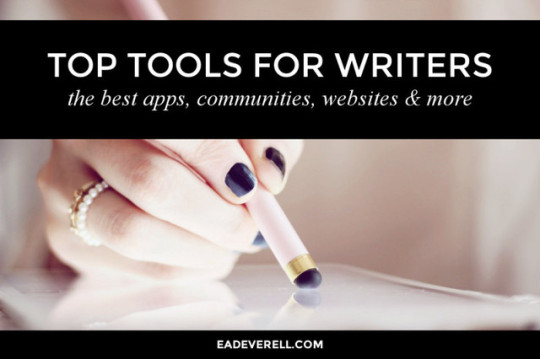
CREATIVE WRITING TOOLS
ONLINE WRITING ENVIRONMENTS
750WORDS – a simple site to keep up a private diary or daily writing practice. You can earn badges and get some neat metrics after you complete your writing.
GOOGLE DOCS – I wrote a whole post about HOW WRITERS CAN USE GOOGLE DOCS!
NOISLI – noise generator and distraction-free writing (with Markdown preview).
WRITE OR DIE – no other app can make you write faster! A NaNoWriMo staple.
WORKFLOWY – a beautifully simple web/mobile app for outlining and list-making.
TWINE – a visual interface for creating “choose your own adventure”-style stories. WATCH THIS VIDEO for a great introduction.
NOTION.SO* – a beautiful web (+Mac & iOS) app for writing and/or creating worldbuilding wikis. CLICK HERE TO SIGN UP and earn 150 extra content blocks.
STATIONERY
GALEN LEATHER – beautiful leather traveler’s notebooks, pen cases, notebook covers and more.
CULTPENS – I order most of my fountain pens from CultPens in the UK. My go-to pens are the Kaweco Sport, Conklin Duragraph and Pilot Penmanship.
PAPERCHASE – I love Paperchase padfolios!
MAC APPS FOR WRITERS
SCRIVENER – excellent for organising (and reorganising) longer projects. If you use Scrivener for novel writing, you might like to download my ONE PAGE NOVEL TEMPLATE.
NOTATIONAL VELOCITY – I use this for all odd notes. It’s quick, simple, beautiful, and saves all files as .txt.
FLUX – Flux automatically adjusts the colour temperature of your screen according to the time of day. I find it really helps me with eye strain!
SOCIAL MEDIA & EMAIL MARKETING
BUFFER – I love Buffer not just for their amazing app, but also because they write the best blog on social media.
ACTIVECAMPAIGN* – I have yet to find a more elegant solution for automated email campaigns.
CONVERTKIT* – another fantastic email marketing solution, especially for email courses.
MAILERLITE – a great free solution for drip-style email automation.
BOARDBOOSTER* – allows you to automate posting to your Pinterest boards. Free for the first 100 pins.
CHROME EXTENSIONS FOR WRITERS
NOISLI – simple and beautiful noise generator which allows you to create and save sound combinations.
LANES – if you’re a fan of the Pomodoro Method, this is a lovely extension that turns your new tab page into a pomodoro timer and todo checklist.
MOMENTUM – similar to Lanes, this extension turns your new tab into a beautiful dashboard.
DRAFTBACK – an amazing extension that helps you visualise the writing and editing of Google documents. READ MORE HERE.
STAYFOCUSED – block yourself from time-wasting sites. I use this to combat my Youtube addiction.
ONLINE WRITING COURSES
THE WRITEMBER WORKSHOP – my friend, Faye Kirwin’s beautiful course on making writing an easy, joyful, daily habit.
THE ONE PAGE NOVEL – my course on how to plot your novel on one A4 page.
HOW TO BE THE HEROINE OF YOUR OWN STORY – my course on how to develop your character (and yourself) on one page.
MASTERCLASS WITH JAMES PATTERSON* – bestselling author, James Patterson’s tips for writing a novel.
LEARN SCRIVENER FAST* – Scrivener is an incredibly powerful piece of software, but if you’re having trouble getting started with it, this course can help!
ONLINE WRITING COMMUNITIES
MYWRITECLUB – a site for communal writing sprints and word tracking. You can follow me HERE.
4THEWORDS – a fun, gamified writing community where you battle monsters as you write, complete quests and earn crystals.
WORDWAR.IO – word war chatrooms from the creator of Write or Die.
IOS APPS FOR WRITERS
SCRIVENER FOR IOS – this is hands-down the best and most beautiful iOS word processor.
HANX WRITER – I’ve written about how much I LOVE HANX WRITER before.
NOTABILITY – this is a great app for importing PDFs (such as WRITING WORKSHEETS) and handwriting over them.
AMBIENT NOISE
I find ambient noise to be extremely helpful when I’m trying to focus on writing. In addition to the previously-mentioned NOISLI, here are a few sites/apps you might like to try…
AMBIENT-MIXER – Ambient-Mixer allows you to create your own custom soundscapes, or to use ones created by other users. My favourite is THIS HOGWARTS LIBRARY MIX.
BRAIN.FM – in all honesty, I didn’t think this worked for me, but I’ve seen many people swear by it, so it’s worth a try.
COFFITIVITY – if you’d like to create a café atmosphere in your home, this is the web/mobile app you want.
ONLINE PUBLISHING COMMUNITIES
Wattpad – Wattpad’s strength lies in its mobile app which is very convenient for reading. It also provides great opportunities to connect with your readers and some basic metrics on how they are engaging with your stories. – Since my account was deleted without reason or warning, I can sadly no longer recommend Wattpad as a safe platform to share stories.
GOODREADS – you might not be aware that you can actually publish your own stories on Goodreads. You’ll need to login, GO TO THIS PAGE, then find the small link that says, “my writing”. I admit I haven’t tried it yet, but I love Goodreads as a book community, so I have high hopes. :)
PRODUCTIVITY TOOLS
THE PRODUCTIVITY PAGES – my paper-based goal and task-tracking solution for writers.
TODOIST – a beautifully minimal to-do list app.
RESCUETIME – automatically tracks how much time you use in each app, and gives you a productivity score based on which apps or websites you designate, “productive” and which “distracting”.
TRELLO* – a task-management app that uses boards, lists and cards. A very nice solution if you like a more visual approach. I also recommend adding the SLIM LISTS CHROME EXTENSIONto fit more on your screen.
PDF TOOLS
DOCHUB – PDF editor that you can add to your Google Drive contextual menu, or as a Chrome app.
SMALLPDF – some fantastic PDF conversion and compression tools!
PDFESCAPE – this tool makes me SO HAPPY! You can upload your PDFs and quickly and easily turn them into forms. Love it.
IMAGES
FIRMBEE – a collection of public domain mockups to use for marketing your books.
UNSPLASH – gorgeous public domain photos to use in your blog posts, book covers, or social media graphics.
GRAPHICBURGER – mockups and graphics to use in your ebooks or emails.
CREATIVEMARKET* – a great resource for images, fonts, templates and themes. Don’t miss their weekly free goods!
CANVA – an online image editor that has pre-made templates for Kindle ebook covers.
WEB SITES
WORDPRESS – my site runs on WordPress. I love it, although it can be a bit intimidating if you aren’t very tech-savvy.
ANGIEMAKES* – my WordPress theme is by AngieMakes. It has a ton of options and I really love it!
SITEGROUND* – my web host of choice. Their premium support is top notch!
MISCELLANEOUS
HOTJAR* – create heatmaps of your blog to see where viewers are looking and clicking.
WAVE – As far as I know, this is the only free accounting solution for freelancers and small businesses, and it works a treat!
https://www.eadeverell.com/creative-writing-tools/
1 note
·
View note
Text
Chauffeurs Face Vehicle loan Crackdown To Steer clear of New Financial Crisis.
Tecmo Koei could be most widely known, or perhaps well known for their Fighters set from video games, however as I've know very first hand, there is actually a larger set of skill-sets they may display when they would like to. While often remaining firmly rooted within Oriental society as their bread and butter, some of the standouts was actually Toukiden. A lengthy warranty, unlike new automobile cover, is actually not goinged by the EU Block Exception guidelines which enable brand-new automobile managers to search when receiving their autos fixed. They are entitled to time to become on their own in the same way that much larger novels do. The really good ones rank a few of the very best jobs from written phrases - give them lifestyle by giving them more opportunity in comparison to they need to have.
Actually BMW supplies a variety of pure burning, crossbreed and also pure electricity cars; the BMW i3 is actually offered in both hybrid and pure-electric versions. If you have any concerns regarding where and ways to utilize visit the next document, you could contact us at the page. The couple additionally profess that both neighbors have possessed autos stationed in locations which stop all of them receiving their vehicle revoke their space and also onto the road. Other voice controls feature remote control engine visit, door lock as well as unlock, flash illuminations or honk the horn and vehicle finder.
I do see to it they hang around outdoors, and also enjoy various other good ideas like reading through books, going to songs sessions and building fancy items out of old cornflake boxes. If Sony didn't respect on the internet multiplayer, they wouldn't have developed a development gulf" into the PS2 from the get go for the high speed broadband adaptor.
As you can easily view off account, the automobile on the Skoda stand that's enticing a big volume of focus is actually the Vision S - essentially, the significant Sport Utility Vehicle that Skoda will certainly introduce later on this year, yet thinly disguised as a concept. A vehicle proprietor with a safety criticism regarding his/her lorry can easily likewise report that to the The Office of Defects Examination (ODI) on the internet site. After you have given your car to the charitable organization you will definitely acquire a tax obligation deduction in the quantity of the purchase from your vehicle.
This work makes certain that the squadron from autos are kept in excellent condition to make sure that the impression actually is actually an excellent one. That does not have the insane tire-shredding capabilities of a Mercedes E63 AMG wagon, yet that checks off the right cartons to be my excellent daily motorist and household auto. Fortunately for guys is this distinction begins to dramatically level as male chauffeurs get older.
On Might 6, 2016, the Exchange Diary declared Apple was actually eyeing up a massive property in California to check out its secretive driverless Apple Automobile job. The company is investing greater than $1 billion over 5 years in expert system developed to earn their vehicles smarter-and ward off disruption or even irrelevance from their well-funded, tech-savvy rivals.
A manual may be actually chosen in approximately one style classification, however can additionally be recommended in the Goodreads Writer category. As if that wasn't enough for the business, this had soon created a car of its very own to evaluate with, correctly got in touch with the Google Automobile, which can be seen strolling the roads from northern California for testing. Unlike people, cars do not experience fatigue, they don't experience driver anger, and they can not knock back 6 pints of beer prior to attacking the road - however they can still create mistakes.
Having said that, this commonly certainly not the situation as chiropractic physicians are actually very knowledgeable about. The absolute most typical disorder that arises from an automobile collision is whiplash. Add animations/image swaps for right and correct turns (move the physical body of the vehicle in the opposite direction, the tires remain) and brakes (relocate the physical body ahead) as well as acceleration (body steps backwards). It additionally develops cars and trucks in behalf of makers like BMW, Audi, Fiat, Peugeot, and Aston Martin.
In the beginning - as well as our experts are actually speaking about the upcoming handful of years - autonomous cars and trucks are going to possibly go no more than 'vehicle driver aid', periodically nudging you along when in a slow web traffic. In spite of Google's fidelity to its own distinct style language, YouTube oftens be actually a great iOS citizen, supporting AirPlay.
There's procedure to his madness as he finds yourself being actually pretty good at it. Inventor Vince Gilligan has generated such a good group of personalities, he is presently extracting the same world again with Better Telephone call Saul. All are budget friendly, and definitely more affordable in comparison to investing in for a new automobile.
In evaluation to titles including Forza or even Gran Turismo where the concentration of the activity begins as well as finishes with the managing from their autos, Task Cars takes into account all facets of its gameplay, featuring the motorist. Nonetheless, if yours is actually an auto that features a keyless entrance system, which unlocks the auto for you automatically when you pull the door handle, this might merely re-open the vehicle. Yet as the Tesla case has proved, as autos come to be extra self-governing, that ends up being substantially more difficult to delegate liability.
0 notes
Text
Among the Red Stars will be out in just under a month now, so I’m thrilled to have author Gwen C. Katz on the blog today to talk about this wonderful new YA historical fiction novel as well as the incredible women who inspired it.
Wine Pairing
I paired Among the Red Stars with this Shooting Star Merlot. Not only does this wine make me think of the the women from Aviation Group 122 soaring across the night sky, but with its tannins and rich flavor profile, it certainly packs a punch, just as the Night Witches did.
*All wine recommendations are for those of legal drinking age only.*
About the Book
Title: Among the Red Stars
Author: Gwen C. Katz
Pub. Date: October 3, 2017
Publisher: HarperTeen
Pages: 384
World War Two has shattered Valka’s homeland of Russia, and Valka is determined to help the effort. She knows her skills as a pilot rival the best of the men, so when an all-female aviation group forms, Valka is the first to sign up.
Flying has always meant freedom and exhilaration for Valka, but dropping bombs on German soldiers from a fragile canvas biplane is no joyride. The war is taking its toll on everyone, including the boy Valka grew up with, who is fighting for his life on the front lines.
As the war intensifies and those around her fall, Valka must decide how much she is willing to risk to defend the skies she once called home.
Inspired by the true story of the airwomen the Nazis called Night Witches, Gwen C. Katz weaves a tale of strength and sacrifice, learning to fight for yourself, and the perils of a world at war.
Author Interview with Gwen C. Katz
1. Most of the the amazing airwomen featured in Among the Red Stars are real people. Was there one woman in particular that you most enjoyed researching and learning about?
I really love all of them, but the lovably nerdy Zhenya Rudneva (called Zhenechka in the book to differentiate her from the other Zhenyas) has a special place in my heart. Her diary entries are filled with a very sweet innocence that you don’t expect from someone fighting a war.
2. Do you know if any of the Night Witches are still alive today and, if so, have you gotten to meet any of them?
The last living Night Witch, Yevdokiya Pasko, died this year on January 27 at age 98. As far as I know, the last living member of Aviation Group 122 is Galina Brok-Beltsova, who was a navigator in the female day bomber regiment, the 125th Guards. She’s 90 years old today, and like Valka, she enlisted when she was just 18. I deeply regret that I’ve never had a chance to meet any of them, but most of them lived very quiet lives and never traveled outside Russia.
3. There is such an incredible cast of characters in this book. Out of all of them, who was your favorite to write about?
People who create conflict are always fun to write. The Kazarinova sisters aren’t true villains, per se, but they get to work at cross purposes with the protagonists, so they get to provide a different perspective to the story, and I enjoy that
4. It appears that Pasha has Synesthesia, a neurological phenomenon in which some people can hear colors or see sounds. In some situations, like when playing music, it seems like that condition could be quite wonderful and beautiful, but on a battlefield, I imagine it would only add to the horror of the situation. What inspired you to make that condition part of his story?
I’m a synesthete myself. It’s a condition I haven’t seen a lot in fiction and I thought it was a great way to literally visualize what Pasha was experiencing. I’m a color-grapheme synesthete, a common type where I visualize words and letters as different colors, but I made Pasha a chomesthete, someone who perceives sounds as different colors, because that struck me as the most emotionally rich type.
5. I loved the bond and loving relationship between Valka and Iskra, as well as the sisterhood and camaraderie that existed between all the women of Aviation Group 122. Were those bonds inspired by any real life situations you’ve been in?
My sister and my friend Katt are both people who have been in my life from day one and I could not imagine life without either of them, and I think I drew from those relationships a good bit. But I think the “bond of sisters” formed by facing death together is probably something you can’t truly know unless you’ve been in that situation.
6. This book include so many wonderful details about the time period, the living conditions of the Night Witches and the soldiers, and the planes. How much research did you have to do to bring this story so fully to life?
Learning Russian was an absolute necessity. I’m lucky that this is a very well-documented period of history and several of these women wrote memoirs, but most of them haven’t been translated into English. Reading about their experiences in their own words provides a lot of detail and perspective you don’t get from purely factual accounts.
7. For readers wanting to learn more about the incredible women in this book, what resources would you recommend to them?
My favorite book about Aviation Group 122 is A Dance with Death by Anne Noggle. She was herself a Women’s Airforce Service Pilot (WASP) during World War II and in the 90s she went to Russia and put together this book of memoirs. For a more informational book, Wings, Women, and War by Reina Pennington is excellent. But Elizabeth Wein is writing a nonfiction book about Aviation Group 122 right now, so all these books may soon be superseded!
8. I adored this book, and I can’t wait to hear about what you’ll be writing next. Do you have any current projects in the works that you can tell us about?
Yes! My new project is about lesbians who served in the Women’s Army Corps. For many young lesbians in the 1940s, the army was the first place where they met other women like them and came to terms with their sexual identity, but they faced court martial and severe punishment if they were found out. This is another World War II project, but it will have a very different feel from Among the Red Stars.
9. If there is any one thing that you would like readers to walk away with after reading Among the Red Stars what would that be?
Follow your dreams!
My Review
Among the Red Stars is a gripping new YA historical fiction novel based on the true story of the indomitable and inspirational airwomen the Nazis dubbed the Night Witches.
This story of a group of young women risking everything to fight against the Nazi regime is exactly what our world needs right now. This book is a very timely reminder of all the sacrifices men and women across the globe made to try to put an end to genocide and hate.
I absolutely fell in love with the characters in this story. Valka is such a smart and fierce young woman, and it was so inspiring to watch her fight to achieve her dreams and to protect the country she loves. Most of the other airwomen in this story are straight out of the history books. Gwen C. Katz did such a phenomenal job incorporating their stories into this book. I was utterly captivated by each of them and would highly recommend hopping online as you’re reading this book and learning more about these astounding women as you go.
Among the Red Stars also incorporates some important messages about friendship and the importance of women loving and supporting other women, and it includes all these vital messages and themes within a plot that is action-packed, fast-paced, and wholly entertaining.
This book is historical fiction at its finest. It not only is a wonderful story in and of itself, but it introduces you to some incredible women from history and inspires you to learn more about them. One of the things I love about historical fiction is that it opens the door for learning and personal growth if readers take the time to dig deeper. I’m so glad I got the opportunity to do so, because my reading experience with this book is one that I will never forget.
This book is perfect for fans of Code Name Verity and will certainly be enjoyed by readers of all ages.
*I received a copy of this book in exchange for an honest review.*
About the Author
From Gwen C. Katz’s website
Gwen C. Katz is a writer, artist, game designer, and retired mad scientist easily identified by her crew cut and ability to cause trouble. Originally from Seattle, she now lives in Altadena, CA with her husband and a revolving door of transient mammals. She is represented by Thao Le of Sandra Dijkstra Literary Agency.
Website | Twitter | Facebook | Goodreads
Will you be picking up a copy of Among the Red Stars in October? What are some of your favorite YA historical fiction novels?
Follow me online for more YA and Wine!
AMONG THE RED STARS Author Interview and Review Among the Red Stars will be out in just under a month now, so I'm thrilled to have author Gwen C.
#among the red stars#Author interview#Book#Book Blog#Book Blogger#Book Review#book reviewer#Books#gwen c. katz#gwen katz#Read#Read YA#YA#ya book blog#ya book blogger#ya book review#YA Book Reviewer#YA Books#ya fiction#ya historical fiction#ya lit#ya literature#young adult#young adult books
0 notes